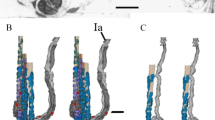Summary
The gastrocnemius muscle of the cat was submitted to ramp stretches and the discharge patterns of primary muscle spindle endings from this muscle were recorded. Up to now, the spindle's stretch response has been characterized by two components: the static response dependent upon the extension length, and the dynamic response, dependent upon the extension velocity. In the present work, besides these responses, an acceleration response was systematically measured for the first time. These is a large positive acceleration response at the beginning of stretch and a smaller negative acceleration response at its end.
The discharge patterns were analyzed at stretch rates of 0–400 mm/sec. A linear relationship was found between increase of static response and length of dynamic response and velocity, and of acceleration response and initial acceleration.
A mathematical model is developed which correctly describes the principal discharge pattern of the muscle spindle in response to a ramp stretch as well as the dependence of the three response components from the respective extension parameters. The basic assumptions are that the muscle spindle is sensitive to length, velocity, and acceleration and that in the extrafusal muscle inertial, frictional and elastic forces will occur during the ramp stretch. The extrafusal muscle and the muscle spindle are thought to represent two transfer units connected in series; so their two transfer equations are coupled according to the rules of engineering control techniques.
In this model the sensitivity to length, velocity, and acceleration is located already in the muscle spindle, whereas the properties of the extrafusal muscle provide smooth and gradual transitions between the individual peaks of the response pattern.
Finally, the models of other authors are discussed, and the significance of the acceleration response is stressed with respect to the servo control system composed of the extrafusal muscle, muscle spindle and spinal cord.
Zusammenfassung
Der M. gastrocnemius wurde rampenförmig gedehnt und eine primäre Spindelafferenz aus diesem Muskel abgeleitet. Das hierbei entstehende Entladungsmuster wurde bisher durch zwei Größen charakterisiert: die statische Antwort und die dynamische Antwort, die von der Dehnungslänge bzw. von der Dehnungsgeschwindigkeit abhängig sind. Neben diesen Antworten wurden erstmals Beschleunigungsantworten am Entladungsmuster systematisch gemessen. Beim Beginn der Dehnung entsteht eine große positive Beschleunigungsantwort und am Ende eine kleinere negative Beschleunigungsantwort.
Das Entladungsmuster wurde für Dehnungsgeschwindigkeiten von 0–400 mm/sec untersucht. Die statische Antwort, dynamische Antwort und Beschleunigungsantwort nehmen linear mit der Länge, Geschwindigkeit und Beschleunigung zu. Es wird ein Modell entwickelt, das sowohl das Entladungsmuster der Spindel als auch die Abhängigkeit der drei Antworten von den Dehnungsgrößen richtig beschreibt. Hierzu wird angenommen, daß die Muskelspindel längen-, geschwindigkeits- und beschleunigungsempfindlich ist und im extrafusalen Muskel während der rampenförmigen Dehnung Trägheitskräfte, Reibung und elastische Kräfte auftreten. Der Extrafusalmuskel und die Muskelspindel werden als zwei hintereinandergeschaltete Regelglieder aufgefaßt und ihre Bestimmungsgleichungen nach den Rechenvorschriften der Regeltechnik miteinander gekoppelt. Bei diesem Modell liegt die Längen-, Geschwindigkeits- und Beschleunigungsempfindlichkeit schon in der Muskelspindel, während der Extrafusalmuskel dafür sorgt, daß die Übergänge zwischen den einzelnen Gipfeln des Entladungsmusters allmählich erfolgen.
Abschließend werden die Modelle anderer Autoren diskutiert, und die Bedeutung der Beschleunigungsantwort für den Regelkreis Extrafusalmuskel-Muskelspindel-Rückenmark wird hervorgehoben.
Similar content being viewed by others
Literatur
Abbott, B. C., andJ. Lowy: Stress relaxation in muscle. Proc. roy. Soc. B146, 281–288 (1957).
Anderson, B. F., G. Lennerstrand, andU. Thoden: Response characteristics of muscle spindle endings at constant length to variations in fusimotor activation. Acta physiol. scand.74, 301–318 (1968).
Bessou, P., Y. Laporte, andB. Pagés: Frequencygrams of spindle primary endings elicited by stimulation of static and dynamic fusimotor fibres. J. Physiol. (Lond.)196, 47–63 (1968).
Crowe, A., andP. B. C. Matthews: The effects of stimulation of static and dynamic fusimotor fibres on the response of stretching of the primary endings of muscle spindles. J. Physiol. (Lond.)174, 109–131 (1964).
Eldred, E., R. Granit, andP. A. Merton: Supraspinal control of the muscle spindles and its significance. J. Physiol. (Lond.)122, 498–523 (1953).
Emonet-Dénand, F., Y. Laporte etB. Pages: Fibres fusimotrices statiques et fibres fusimotrices dynamiques, chez le lapin. Arch. ital. Biol.104, 195–213 (1966).
Grüsser, O.-J., u.B. Thiele: Reaktionen primärer und sekundärer Muskel-spindelafferenzen auf sinusförmige mechanische Reizung. Pflügers Arch. ges. Physiol.300, 161–184 (1968).
Harvey, R. I., andP. B. C. Matthew: Some effects of stimulation of the muscle nerve on afferent ending of muscle spindles, and the classification of their responses into type A1 and A2. J. Physiol. (Lond.)156, 470–497 (1961).
Henatsch, H.-D.: Instability of the proprioceptive length servo: its possible role in tremor phenomena. In: Neurophysiological basis of normal and abnormal motor activities, pp. 75–90. Ed.:M. D. Yahr andD. P. Purpura. New York: Ravens Press 1967.
Houk, J. C., R. W. Cornes, andL. Stark: A model of adaptition in amphibian spindle receptors. J. theoret. Biol.12, 196–215 (1966).
Katz, B.: Efferent regulation of muscle spindles in the frog. J. exp. Biol.26, 201 bis 217 (1949).
—: Depolarization of sensory terminals and the initiation of impulses in the muscle spindle. J. Physiol. (Lond.)111, 261–282 (1950).
Lennerstrand, G., andU. Thoden: Dynamic analysis of muscle spindle endings in the cat using length changes of different length time relations. Acta physiol. scand.73, 234–250 (1968).
Matthews, P. B. C.: The differentiation of two types of fusimotor fibres by their effects on the dynamic response of muscle spindle primary endings. Quart. J. exp. Physiol.47, 324–333 (1962).
—: Muscle spindles and their motor control. Physiol. Rev.44, 219–288 (1964).
Oppelt, W.: Kleines Handbuch technischer Regelungsvorgänge. Weinheim/Bergstraße: Verlag Chemie 1964.
Pressler, G.: Regelungstechnik, Hochschultaschenbücher-Verlag. Mannheim: Bibliogr. Inst. 1964.
Rack, P. M. H.: The behaviour of a mammalian muscle during sinusoidal stretching. J. Physiol. (Lond.)183, 1–14 (1966).
Reichel, H.: Muskelphysiologie. Berlin-Göttingen-Heidelberg: Springer 1960.
Schäfer, S. S.: The acceleration response of a primary muscle spindle ending to ramp stretch of the extrafusal muscle. Experientia (Basel)23, 1026 (1967).
—, u.H.-D. Henatsch: Dehnungsantworten primärer Muskelspindelafferenzen bei elektrischer Reizung und natürlicher Innervation der beiden fusimotorischen Fasertypen. Exp. Brain Res.4, 275–291 (1968).
Shephard, G. M., andD. Ottoson: Response of the isolated muscle spindle to different rates of stretching. Symp. quant. Biol.30, 95–103 (1965).
Toyama, Keisuke: An analysis of impulse discharges from the spindle receptor. Jap. J. Physiol.16, 113–125 (1966).
Author information
Authors and Affiliations
Additional information
Mit Unterstützung der Deutschen Forschungsgemeinschaft.
Rights and permissions
About this article
Cite this article
Schäfer, S.S., Schäfer, S. Die Eigenschaften einer primären Muskelspindelafferenz bei rampenförmiger Dehnung und ihre mathematische Beschreibung. Pflugers Arch. 310, 206–228 (1969). https://doi.org/10.1007/BF00587210
Received:
Issue Date:
DOI: https://doi.org/10.1007/BF00587210
Key-Words
- Primary Muscle Spindle Ending
- Acceleration Response
- Stretch Sensitivities
- Mathematical Model of a Spindle Ending




